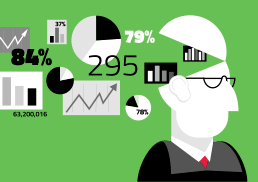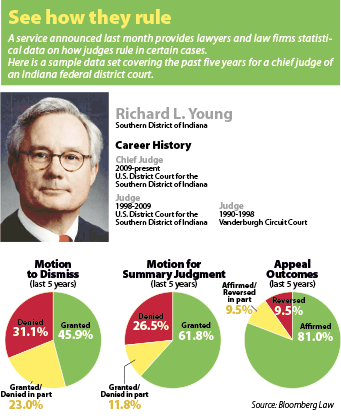Subscriber Benefit
As a subscriber you can listen to articles at work, in the car, or while you work out. Subscribe Now
 Attorney Arend Abel frequently gets questions from clients that he can’t answer straightaway, though he does his best to try to get an informed response.
Attorney Arend Abel frequently gets questions from clients that he can’t answer straightaway, though he does his best to try to get an informed response.
“One of the questions I’m routinely asked by clients is, ‘When are we going to get a ruling?’” the Cohen & Malad P.C. partner said. “The short answer is, ‘We don’t know for sure.’”
Nevertheless, Abel and other lawyers said such an inquiry usually is the beginning of at least a limited research project. They look through orders, measuring how long the judge on their case has taken to rule in similar matters, and they use what they find to offer clients a general idea of what to expect based on past performance.
But that sort of information now may be just a few clicks away. Bloomberg Law last month announced the addition to its subscription services of Litigation Analytics, which provides searchable performance measures for district court judges.
“The main idea behind this is predictive analytics,” said Darby Green, a former litigator who is commercial product director for Bloomberg Law. “It’s enabling lawyers to help formulate their strategy and better predict outcomes, time and costs.
“We’re the first and only source for this kind of information,” she said.
Data, sliced and diced
Litigation Analytics will tell you this, for instance, about Chief Judge Philip Simon of the U.S. District Court for the Northern District of Indiana: He takes, on average, a bit more than a year to rule in employment cases; the firm of Christopher C. Myers & Associates most frequently appears in cases before him; and he gets affirmed in 73.7 percent of all appeals, reversed in 15.8 percent, and affirmed in part and reversed in part in 10.5 percent. Simon declined to comment for this article.
But information of that sort just scratches the surface. Cross-referenceable data sets include individual judges’ percentages for granting motions to dismiss and motions for summary judgment, as well as the law firms and companies that have appeared before judges.
For years, Bloomberg has collected and databased millions of publicly available federal court opinions in addition to the information it collects on millions of businesses. Green said that by using machine learning, the company has been able to sort opinions by judge, parties and law firms representing them.
As a result, the Litigation Analytics data can be filtered to show how judges have ruled on dispositive motions in cases where particular parties or law firms are involved.
Chief Judge Richard Young of the U.S. District Court for the Southern District of Indiana said he didn’t find much surprising about statistics on how he’s ruled on dismissal and summary judgment motions and reversal outcomes on appeal. He said the administrative office of the federal courts annually compiles stats tracking types of cases and time to disposition, for example, though that data is broken down by district courts and not individual judges.
Young didn’t see any issues with lawyers having access to this kind of information about particular judges.
“It seems to me it’s all public record anyway,” he said. “The folks at Bloomberg are just compiling all that information and putting it into a graph to make it simple to understand.”
But Abel wasn’t sure all judges would be as understanding. “My belief is, judges are probably not going to be thrilled.”
Analytics inevitable?
Ogletree Deakins Nash Smoak & Stewart P.C. shareholder Robert Seidler, like Abel, often gets asked to predict how long something might take or how a judge might be inclined to rule on a motion.
 Seidler
SeidlerLawyers may or may not have information at their disposal to provide to a client, but even when they do, the information is likely to be anecdotal without some time spent on research, said Seidler, who’s also president of the Indianapolis chapter of the Federal Bar Association.
Statistical data on performance ratings has been around for decades in everything from baseball to human resources, Seidler observed. Now that analytics on law firms and even individual attorneys are available on the legal-services market, he said, “It was only a matter of time before someone decided to gather this information” about judges.
“Information is power,” Seidler said. “I can imagine our clients would be very interested in that information.” Bloomberg isn’t currently tracking data on magistrate judges, and Seidler suggested that data also could be useful for lawyers and clients.
Because federal district courts randomly assign cases to judges, the value of the data comes from its ability to measure a judge’s past performance in given case types and where certain parties or firms are involved and tailor the information for clients. It could help determine whether filing dispositive motions are worth a client’s time and money, or whether a different strategy might be more prudent.
“I think our federal judges take each matter on its own merits, but obviously, any information on how a judge has ruled in the past on similar issues, whether they’re generally disinclined to grant motions to dismiss or motions for summary judgment, that’s useful information to have,” Seidler said.
 The value proposition
The value proposition
Green and Bloomberg BNA Director of Corporate Communications David Peikin declined to provide examples of pricing for the company’s subscription services. “There’s a wide array in the way it’s priced,” Peikin said, noting the service is provided through licensing agreements.
Green said flexible pricing makes Bloomberg Law’s services available to firms regardless of size, and Litigation Analytics won’t be offered as a standalone product. She said its data could be particularly useful for smaller firms that might not have the time or resources to devote to independently researching a judge’s ruling history. Armed with the information, “A mid-sized law firm could really win the day,” she said.
“There’s no question that it’s valuable,” Seidler said, noting that in addition to the value it provides clients, firms could save money by freeing up staff to devote their time to other matters. Abel agreed.
“What this would do is automate one of the things we’re already doing,” he said. “This would be a relatively easy way to provide clients with more information without spending huge amounts of time gathering that information.”
But Abel said attorneys shouldn’t look at analytical data as a crystal ball, and he cautioned against overreliance on aggregated statistics. He said judges already face pressure to rule in a timely fashion, and their caseloads vary at any given time. Criminal cases and injunction cases on a judge’s docket take priority over civil cases, for instance, so what’s on a judge’s plate could lengthen or shorten times to decision. And that’s the kind of information that won’t likely be found in a database.
Because every case is different and has its own set of facts, the statistics may give “a misleading picture” of what’s likely to happen in a case, he said.
“I don’t think it’s going to be predictive of anything,” Abel said, but “more information is invariably better. … Clients always want more information” and analytics may be useful “as long as clients are cautioned and lawyers are cautious not to overread the data or draw conclusions.”•
Please enable JavaScript to view this content.

